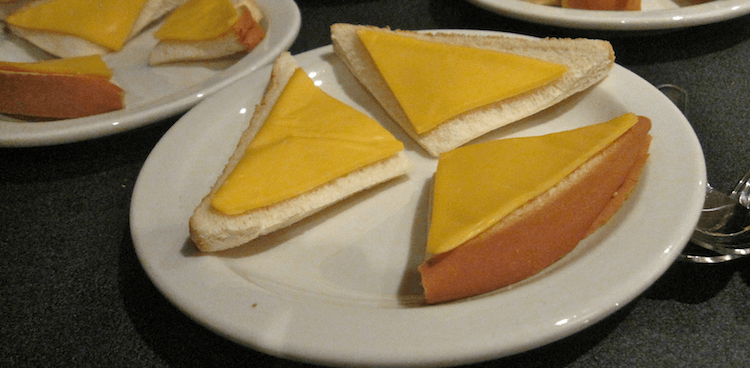
Hold on to your blue boxes and your viscous yellow liquids! This blog series will take you on a wild ride through the history, politics, science, and culture of processed cheese, including the origins of factory cheese, the rise of James L. Kraft, and the miracle of milk protein concentrate. Snoop around last week’s post on the Kraft Krusade for total cheese-dominance.
By the end of the 1920s, J. L. Kraft & Bros. was doing very well for itself. The company was making tens of millions of dollars from its futuristic, sanitary tin-canned cheese, and most Americans found that they preferred the newfangled dairy product over the age-old, traditional cheeses they’d been stuffing in their mouths since time immemorial. Like cream rising to the top of the pail, Kraft had roundly beaten or bought out many of its competitors and rivals to emerge pretty much victorious as the United States Cheese King. Yet Kraft and Co. wasn’t content to continue selling the same old thing. Dreams of dollar signs spurred the company onward to brighter and cheesier things: the American Single and Macaroni and Cheese. This week, real cheese product is tackling the former; check in next week to discover the innermost secrets of the ubiquitous blue box.
Part I: The American Single
Kraft’s new process cheese was a smashing success—consumers could now buy consistent, creamy cheese-in-a-can that lasted forever! This was an easy cheese to wrap your head around: open the can, cut off a slice, and there you go. But in the never-ending quest to make things even easier, Kraft & Bros. decided they could eliminate the entire cutting-the-cheese part of the process altogether. If they could just figure out a way to package their process cheese in pre-cut slices, they would have an even bigger moneymaker on their hands.
The problem, of course, is that this process cheese was exceedingly hard to cut unless it already was in the can. Remember, James Kraft’s process wonder-cheese was arrived at by stirring cheddar (and later an assortment of other cheeses) for fifteen minutes at 175º F. The end result was a gloopy, hot mess that was poured directly into the tin cans. As a contemporary New York Times article on the subject describes it, “cutting hot cheese was like trying to slice molten lava.”
At this point, I advise transferring your readerly gaze from James L. Kraft to his brother Norman. Norman had risen in the ranks to become head of research, and the conundrum of sliced cheese (comparable to that of the Gordian Knot) occupied a good deal of his attention. He hammered away at the problem for years, but a satisfactory method of slicing this cheese was yet to be found.
Fortunately, the cheese gods decided to smile down upon the Kraft brothers, and in 1935 Norman Kraft arrived at an epiphany. A big part of the problem was the heated viscosity of the cheese—if the cheese could be cooled down, it could be sliced a lot more easily. So instead of cutting the cheese in the can, Norman poured the cheese over large, chilled stainless-steel surface. To ensure the cheese was level, he flattened out the cheese with a big, cold rolling pin. Finally, he cut the cheese into 3” square slices.
The central idea to the slices was sound, but it would take another fifteen years for him to truly master the implementation of the process. Eventually Norman came up with a mechanized “chill roll” which automatically cooled the cheese and sliced it into squares, which were then packaged in a stack of eight peelable cheese slices. And so, in 1950, Kraft debuted their De Luxe Process Slices. The nation gobbled it up. Modern Packaging magazine proclaimed that the future was now: “all of the handicaps of store-sliced cheese—variations in thickness of slices, slivered edges, imperfect packages, drying out, curled ends, etc.—are overcome.” According to The Progressive Grocer, cheese sales consequently rose 150 percent in some places.
Still, the wheels of cheese progress refused to stop turning, and it wasn’t long until a native son of Indiana, Arnold Nawrocki, came with a patent for “an apparatus for producing individually wrapped slice-like slabs of cheese products”—for the first time, cheese-citizens from around the globe could enjoy single slices of cheese wrapped in their own plastic packaging to ensure complete freshness. By 1965, Kraft got on board and came up with its own version of the technology, and thus the American Single (probably three times as crazy-awesome as sliced bread) ingratiated itself into our cheesy way of life forever.
Next it’s on to the crown jewel of the Kraft Empire, Macaroni and Cheese! Learn about its origins as a fave of Thomas Jefferson to its modern incarnation as Depression-era meal solution in next week’s installment of real cheese product.






